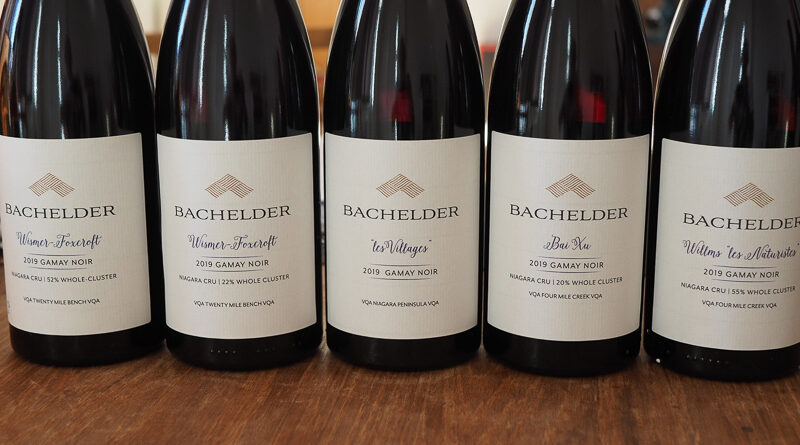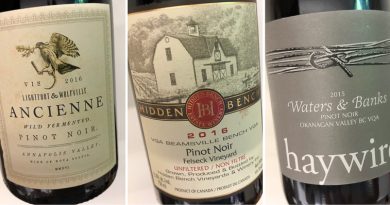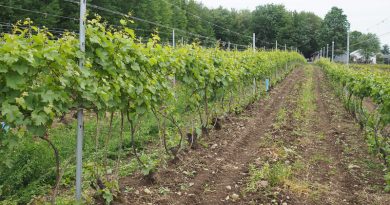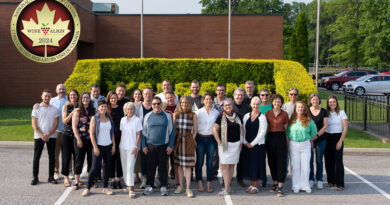Thomas Bachelder is taking Gamay to the next level in Canada’s Niagara region
‘Niagara is on a learning curve,’ says Thomas Bachelder about Gamay. Thomas is one of the most respected winemakers in Niagara, and as well as making wines here he has also used the Bachelder brand for wines he’s made in Orgeon and also Bourgogne. Pinot Noir and Chardonnay are his passions, but of late he’s become more and more interested in Gamay, which is establishing itself as a star performer in Niagara. [Aside: other Gamay producers to look out for in Niagara include Malivoire (a specialist), Château des Charmes, Tawse, Pearl Morissette, Leaning Post, Southbrook, Rosewood and 13th Street.]
I’m a Gamay fan too, and one of the things I love about it is that its unassuming. You don’t have the leading critics giving 100 points to Gamay, and this appeals to me. When you go to Beaujolais, even the fanciest wines are affordable: if you can get hold of it (often the issue with the most sought-after wines), you can afford it. It’s also a variety that has had an important role in the world of natural wine.
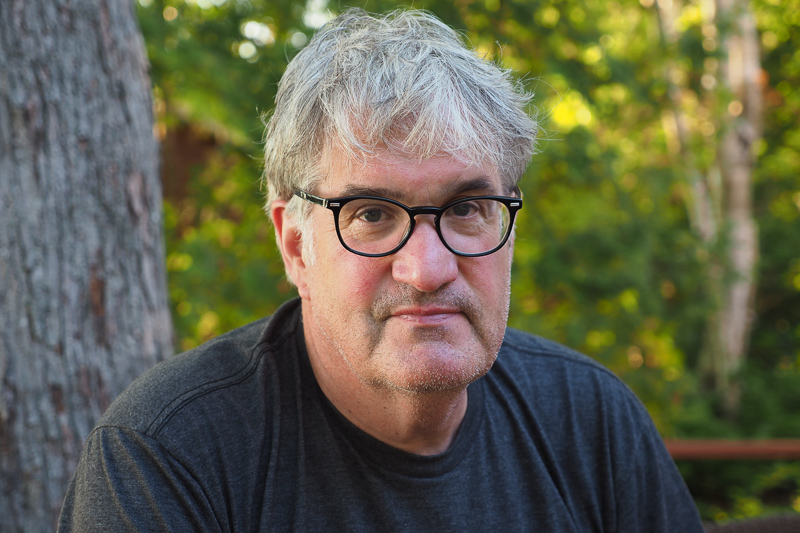
‘For me, Gamay starts in two places,’ says Thomas. ‘It starts very early on: I’m a home winemaker from Montreal, entranced by France. Mary and I went to Beaujolais when we were very young, and I went to what looks like a home winemakers store, but in France they are home bottler stores. You can go to the coop and buy a demijohn of 56 litres and bottle it at home. You find corking supplies, you find corkers, labels and bottles, you don’t find much winemaking equipment. So I went into one of these places in Villie Morgon, and I said, I live in Montreal and I have discovered a couple of cement vats in my cellar that the Portuguese Candadian landlord built. I said, they are disgusting and I’m never going to use them. He replied: monsieur great Gamay is made in cement all the time. He said wash them with a strong base and then paint them with a tartaric acid solution so it will give something for future crystals to hang on to. I became intrigued. I went home and for the next few years before going to wine school I venerated these vats and made wine from California and Niagara grapes. This trip was the start of my love of all things Beaujolais.’
Thomas went to wine school in Beaune so Pinot Noir has always been at the top of his list. It’s his passion, but of late he is turning to Gamay, initially out of necessity. He was making wine in Burgundy, Oregon and Niagara, but the one that sold out fastest was Niagara. He stopped making Burgundy and Oregon wine in 2015. But in Niagare, sourcing enough Pinot was becoming problematic, in a parallel with the situation some winegrowers in Burgundy found themselves in.
‘Burgundians of the north didn’t have enough Pinot so they needed to offer another medium weight, perfumed red, and so many Burgundians now make wine in Beaujolais or bring the grapes back up,’ he says. ‘I started to realise that in Niagara I fight to get good stocks of Pinot, and I’m 70% Chardonnay. If I just make a foray and get three or four Gamay vineyards, pow! So now we are making six Gamays and the whole Bachelder operation is 55% red in Niagara. So we’ve righted the ship just by copying what the Burgundians are doing.’
So Bacheldeder is now Pinot Noir, Chardonnay and Gamay, and the only thing he’ll ever add is Aligoté. Château des Charmes has some, and Marty Werner has planted some for his MW Cellars project, from cuttings taken from Château des Charmes.
Thomas thinks Niagara needs to specialize. ‘We mustn’t be known for 40 different things. We are allowed to have other things, but let’s decide on a few things. Niagara, as you know, seems to be shaping up to be Riesling, Chardonnay, Gamay Noir, Pinot Noir and Cabernet Franc as the most reliable performers every year. They have an ability to display local terroir and they are slightly immune to winter kill in the really hard winters. You can grow Gewurztraminer and Sauvignon Blanc here, and you can grow Viognier and Syrah: they make great wines but they are not very winter hardy.’
‘Winter hardiness is not whether or not the vines die. Lots of times they die back and you can regenerate a trunk, but you lose a couple of years. And sometimes it is just that the dormant buds freeze without dying and you get no crop that year. That is not very viable. This has always been a factor in the last 100 years in Niagara. You have to hill up your vines, but you will get dinged twice a decade. So you better have the grapes that can withstand the winters.’
Thomas explains some of Niagara’s terroir effects. ‘The bench faces lake Ontario, and the bench is the escarpment that the Niagara Falls falls from, or once fell from (it has sort of dug a gorge backwards). The bench and its distance from the lake, the thinness of soils, and dolomitic limestone make for some pretty crunchy mineral wines. That is Wismer Foxcroft.’
‘Niagara on the Lake, just a few metres from the USA border (the Niagara River) sticks out into Lake Ontario, is largely gently sloped, and the soils are deeper and sandier. In general, I like the Pinot Noir from Niagara on the Lake, but I love it from the Bench. Whereas with Gamay Noir, which has a great ability to retain its acidity, from Niagara on the Lake it is just so luscious, gulpable yet serious.’
We also discussed the idea of getting to grips with single vineyards, in regions where this has not been the norm. ‘It behoves one to separate the vineyard out and figure out which the good bit is, by which I mean what the characterful bit is, that is not just a vin de cepage,’ says Thomas. ‘It’s the one that really has something that you can pin as its character. Once you find that character, you can then find the barrels that display that, and display it together harmoniously. If you do single vineyards that way you get to the goal quicker, instead of throwing all the barrels of the single vineyard together, because there is always some background noise.’
Most of his reds are made in blue bins that take just under a ton of grapes (800 kg). The disadvantage of these, says Thomas, is that you have a lot of ferments to worry about. But it also means that you can vary the winemaking and see what works best, not in the service of make-up, but in terms of best expressing the terroir. So when whole bunch is used, he puts some whole bunch at the bottom, or he might layer it with destemmed berries. It’s not carbonic maceration, but the whole bunch portion does a little bit of carbonic. ‘We do get some intracellular fermentation, because when those bunches come out they are still intact, but totally fermented.’
Thomas tries to work only with healthy grapes, in which case there’s no need to add sulfites at the beginning. The first add is after malolactic fermentation has finished. ‘It has become a fun game to see what little sulfites you can add and still have pristine wines,’ he says.
On recent vintages: ‘2019 was a cool and long year, and for me this means a terroir year. We got to the right ripeness but it took a long time. The vine was getting her babies full of other stuff while she waited.’ He says this was a classic cool year. The wines are made in old barrels, and Thomas says that while he can’t yet afford foudres, he is getting some puncheons. These 2019 Gamays show that serious progress is being made with this variety. Thomas is helping to take Niagara Gamay to a new level, in my opinion.
Older notes:
Ring (TR) and I recently tasted through the wines independently.
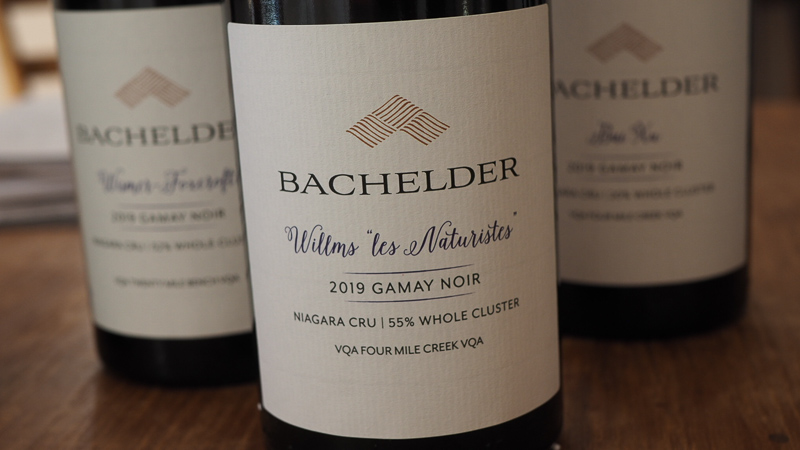
Bachelder Willms Les Naturistes Gamay Noir 2019 Four Mile Creek, Niagara, Canada
12.5% alcohol. 55% whole cluster ferment from old vines planted in 1983. This is so beautifully, exotically floral, with red cherries, cranberries, a touch of undergrowth and just a touch of lift. Very appealing. The palate is delicate, but doesn’t lack flavour with a savoury, spicy edge to the silky fruit, with redcurrant and cherry to the fore. A beautifully expressive wine, finishing with some spice and sour cherry. Lovely detail here, and just so fresh and drinkable. 93/100 (JG)
Les Naturistes comes from a 1983 planted vineyard owned and farmed by the Willms family, in the heart of Four Mile Creek, rooted in silty, loam clays, gravel, limestone and sand. This was fermented with 55% whole cluster. Ample white pepper and alluring spices open this savoury lighter red, flooded with red flowers, crunchy plum, wild raspberry, candle wax, and studded with rock salt. Tannins are fine, hugging this to a lingering spiced finish. 90/100 (TR)
Bachelder Wismer Foxcroft Gamay Noir 22% Whole Cluster 2019 Twenty Mile Bench, Niagara, Canada
13% alcohol. This is meaty and spicy on the nose with a reductive savoury twist to the red cherry and plum fruit. There’s a slightly charred, spicy, mineral, irony reductive note that adds some interest without being too much of a distraction. The palate has more of this savouriness, with a firm grip, notes of blood and iron, and vivid raspberry and cherry fruit. It finishes grippy and taut, showing freshness and depth. Ageworthy, no doubt: this is a substantial wine but it’s all angles and grip right now. 94/100 (JG)
This is one of two 2019 Gamays from Wismer-Foxcroft Vineyard, the special Twenty Mile Bench site known for its exceptional Chardonnays and Pinot Noirs. Planted in 1993 to magnesium and limestone laced soils, this gamay was 22% whole cluster. Opening with a wave a reduction, this then moves into ample cracked pink and black peppercorns, savoury green stem, sapid black plum, wild raspberry, celery, ferrous notes, and a good shake of mineral salts on the finish. Tannins are long and well integrated into the toothsome fruit. More a brooding style, this gamay can handle pouring alongside roast pork and/or wild mushroom dishes. 90/100 (TR)

Bachelder Wismer Foxcroft Gamay Noir 52% Whole Cluster 2019 Twenty Mile Bench, Niagara, Canada
13% alcohol. This has an intriguing spicy, savoury, slightly mineral reductive nose with some taut, floral red cherry fruit. The palate is juicy and lively with some good structure and acidity under the red cherry and raspberry fruit with a spicy graininess. There’s a suppleness to this wine, but also good structure. It has perfume, silkiness, some spicy mineral reduction and nice tannins: it should age in interesting ways. The extra whole bunch component seems to have tempered some of the bloody reductive wildness. It’s the best Niagara Gamay I’ve tried. Almost Côte du Py-like in style. 95/100 (JG)
This is one of two 2019 Gamays from Wismer-Foxcroft Vineyard, the special Twenty Mile Bench site known for its exceptional Chardonnays and Pinot Noirs. Planted in 1993 to magnesium and limestone laced soils, this gamay was 52% whole cluster. This opens with a swing of reduction before moving into a dense, yet elegant palate of fleshy raspberries, cherries, candle wax infiltrated with ample mineral salts, and livened with a green balsam twinge. Very well knit, this is drinking well now and with time ahead. 91/100 (TR)
Bachelder Bai Xu Gamay Noir 2019 Four Mile Creek, Niagara, Canada
12% alcohol. ‘Jackson Bai, a new Canadian, bought this vineyard a few years back,’ says Thomas Bachelder. ‘It is the oldest vineyard in our cellar (planted 1981). We do a Chardonnay and a Gamay out of there.’ Fermented with 20% whole clusters, vines planted in 1981. Light in colour, this is a pure, harmonious, ethereal expression of Gamay with supple green-tinged cherry and plum fruit, with a silky texture and good acidity. There’s just a hint of fine, spicy, almost peppery reduction which adds some framing to the light, transparent fruit. Such beauty here: an exquisite wine. 94/100 (JG)
Jackson Bai and his family own Four Mile Creek’s Bai Xu vineyard, planted in 1981 with unknown clones, on a mix of loamy clay, silt, sand and limestone. This Gamay utilized 20% whole cluster. Pouring a pale crimson hue this finessed gamay opens with bright and lifted cherry blossoms, wild raspberry, candle wax, and a soft dusting of white peppercorn and mineral salts. Tannins are fine and long, hugging this lighter red through the haunting finish. Drinking beautifully now, and with tine ahead. 92/100 (TR)
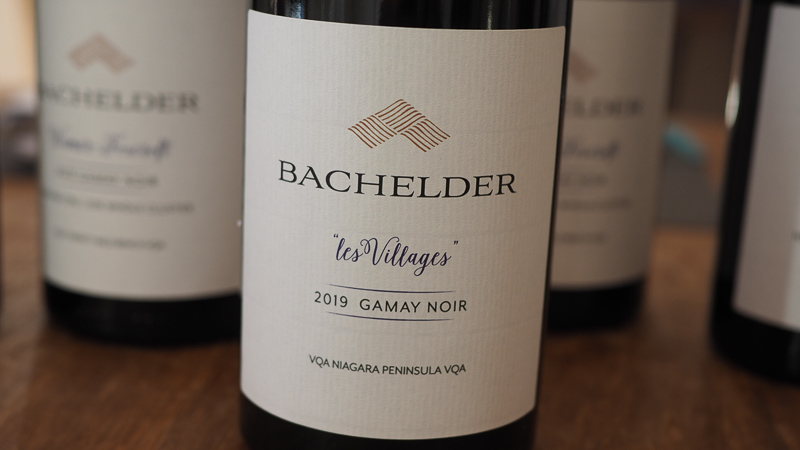
Bachelder Les Villages Gamay Noir 2019 Niagara Peninsula, Canada
12% alcohol. This is a blend of five small lot fermentations with 28% whole cluster. This is midweight with lovely juicy cherry and berry fruit, a touch of raspberry, a slight lift, and really nice balance between the sweet and savoury elements. It shows nice purity and focus, with a juicy red cherry finish and a fine spiciness. A really beautiful, expressive Gamay which has depth as well as freshness, lovely brightness, and real drinkability. An astonishing bargain at $23 in Canada. 93/100 (JG)
Find these wines with wine-searcher.com

